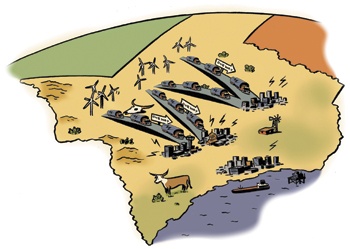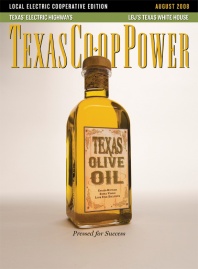There continue to be more and more parts of your electric bill over which we simply do not have control.’
Roland Witt, General Manager
Coleman County Electric Cooperative
Texas is requiring utilities to generate 5,880 megawatts of electric power from renewable sources by 2015 and 10,000 megawatts by 2025. No problem there. Wind power entrepreneurs have created a new energy boom in West Texas. There’s already more wind electricity available than the limited transmission system in the region can handle. And hundreds of private companies have proposed new electric highways. They are waiting for the Public Utility Commission of Texas to determine who will get the cost-plus contracts and where the lines will be constructed.
Most of us would like to be spared the gritty details about the cost of producing electric power. Talking about the cost and reliability of transmission seems even more deadly dull. But Texas Co-op Power feels obliged to bring co-op members an explanation of what we have control over and what we don’t. Today’s subject is transmission, the electric highway in the sky that needs new routes, just like our vehicular highways do.
If you need motivation to read this, all you need to know is that you will pay the cost of these new transmission lines in your monthly electric bills.
The new energy kid on the block—nonpolluting wind—is strongest in the Panhandle and West Texas, but the greatest power need is in the more populous region farther east. So to get those cheaply generated electric volts from sparsely populated West Texas to the big markets, billions of dollars must be spent to build electric lines. And new procedures must be designed to harmonize the output of wind farms with electric energy generated from other sources, mainly natural gas, making sure the instantaneous production of power meets the instantaneous needs of millions of Texans. The new lines must also alleviate congestion around Dallas/Fort Worth, San Antonio/Austin and Houston.
A ballpark figure on the cost of constructing a mile of 345,000-volt transmission line is $1 million, about the cost of building a mile of asphalt highway. The Electric Reliability Council of Texas (ERCOT), the nonprofit grid operator, issued a report in April indicating that constructing transmission lines to transport wind-generated electricity from west to east will require an investment of anywhere between $3 billion and $6.4 billion over the next few years. The ERCOT grid covers about 75 percent of the state and represents 85 percent of the state’s electrical load, including that generated by cooperatives.
THE WIND IS FREE, BUT THE HIGHWAY IS NOT
The Fort Worth Star-Telegram estimates that the most ambitious transmission plan could cost Texans within ERCOT $320 per capita. Barry Smitherman, chairman of the Public Utility Commission of Texas (PUCT), estimates that new wind power transmission should cost individual consumers no more than $4 a month. The Wind Coalition, an association of wind energy businesses, promptly responded to the ERCOT estimates by saying that savings from wind-powered electricity can offset the transmission construction costs within two years by replacing more expensive forms of energy. This could be correct, but the figures come from wind-farm entrepreneurs who are proposing to build more wind farms than Texas could possibly accommodate in the near term.
Cooperatives have a limited number of transmission lines (Brazos Electric Cooperative has 2,577 miles of transmission line, the most of any Texas co-op generator). Although cooperatives can monitor the transmission expansion plans of others and propose new routes that they consider necessary to meet their member loads, co-ops have no authority over where the lines will go or what they will be charged to use them. PUCT makes those decisions.
ERCOT estimates that between 1,600 and 3,000 circuit miles of transmission will have to be constructed in the next five years. The latter figure would be sufficient to carry 17,956 megawatts (MW) of wind-generated electricity. One megawatt provides approximately enough energy to light 500 to 700 homes when the wind is blowing. That equals between 9 million and 12.5 million homes. As of 2000, the U.S. Census Bureau reported that the state had 7.4 million households.
WIND MUST HAVE A PARALLEL POWER
Even if transmission facilities were constructed to connect and transmit all this proposed wind generation, wind energy alone still could not provide reliable service. Because wind energy is intermittent, there always must be conventional generation, primarily natural gas or coal, ready to supplement electricity when the wind either dies down or blows so hard wind generators cannot operate. Electric is also needed to provide what are called “ancillary” transmission services, such as maintaining proper voltage throughout the transmission grid.
Are consumers going to be required to pay for more transmission lines than are needed because more wind farms are being built than can be used? When there’s more electric power available at a particular time of day because the wind is blowing, will conventional plants that burn coal or natural gas have to curtail their output for a few hours? Who decides which electricity uses the grid and who profits? These issues will be in play with wind power and perhaps later with large-scale solar power.
Renewable power, particularly wind, will absolutely be part of all Texas electric companies’ generation portfolios in the future, no matter what kind of new construction is needed. State law requires increasing use of renewables. The bulk of the power is to be transmitted to the populous areas of Dallas/Fort Worth, Austin/San Antonio and Houston. PUCT is studying four proposals that would transmit from 12,000 to 24,000 MW. The agency also will designate specific routes. Wind farm entrepreneurs are participating in routing negotiations. Transmission construction for this round of wind farms should be complete in five years. Proximity to a transmission line may mean the difference between financial success and failure.
There’s even disagreement about how much capacity is available in existing facilities when wind developers who want to use the lines come up against the reliability concerns of transmission operators. As Kenneth Starcher, director of the Alternative Energy Institute at West Texas A&M University, explained, “Imagine a pipeline is half full. Wind farm developers look at a line with only 50 percent of load and see 50 percent unused. The utilities say they need the extra capacity for emergencies, for reliability. The utilities have to plan for the worst possible scenario because the available electric power changes all the time.”
Although the new transmission facilities will raise costs for co-op customers in ERCOT, there is no question that the existing shortage of transmission facilities also can affect what people pay. When transmission lines are not adequate to bring the lowest cost power to an area, they are called “congested,” and the lost opportunities to use lower-cost power are called congestion costs.
In West Texas, one also hears about “stranded” wind. That’s the potential available electricity from already constructed wind farms that has no transmission outlet. Sometimes the fate of electricity generated by wind and coal (a major source of CO2) are conjoined. For example, when the state of Kansas denied an air permit to construct the Holcomb coal plant, developers scrapped plans to build transmission lines from Kansas to the Texas Panhandle. Those same lines would have scooped up stranded wind power and transmitted it to waiting customers on the Southwest Power Pool grid.
Ultimately, PUCT must decide how much additional transmission should be built, where it will be built, who will build it and, of course, who will pay for it. There also will be questions regarding just how much wind can be reliably integrated in the ERCOT grid. “Hopefully, the Public Utility Commission will give thoughtful and objective consideration to these complex issues,” said Greg Jones, chairman of the board of Texas Electric Cooperatives and manager of Cherokee County Electric Cooperative Association.
——————–
Kaye Northcott is editor of Texas Co-op Power.


